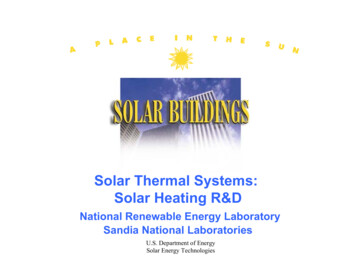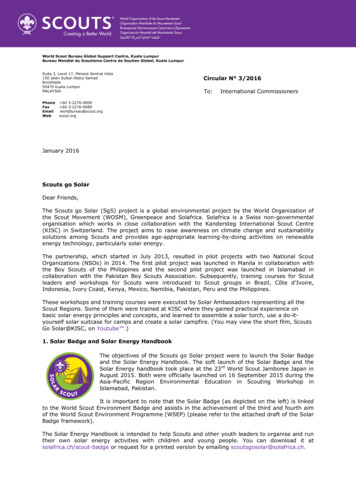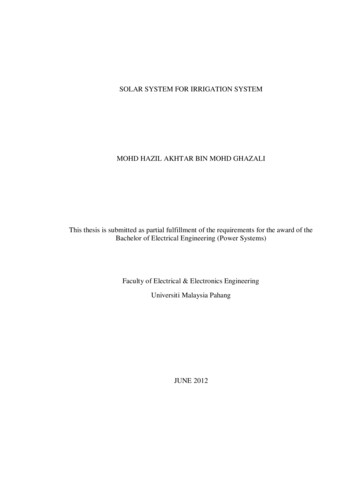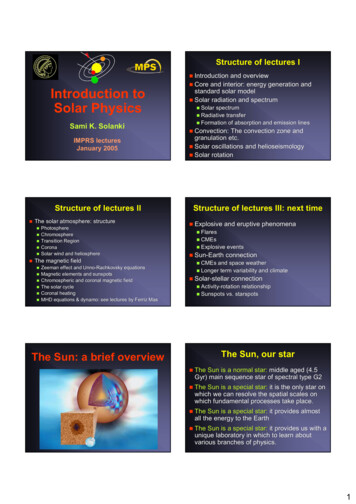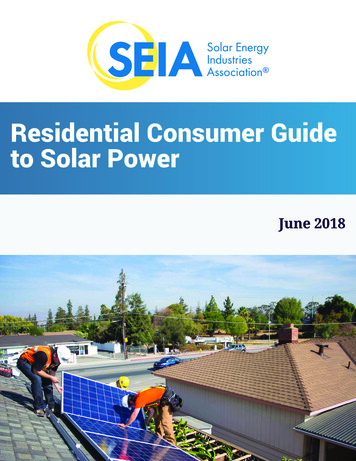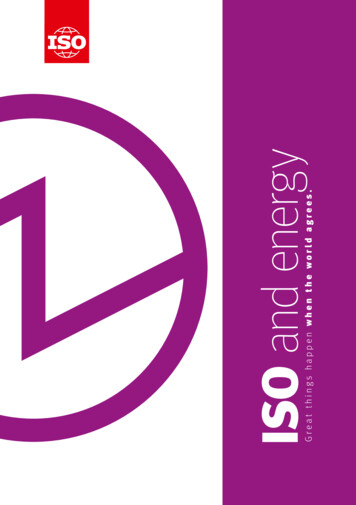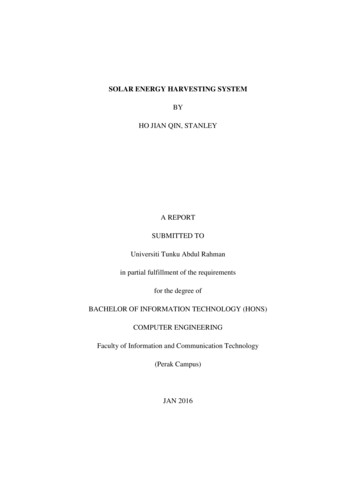
Transcription
Review Paperdoi:10.5937/jaes14-10879Paper number: 14(2016)4, 405, 481 - 491AN INTRODUCTION TO SOLAR CELLTECHNOLOGYKiran Ranabhat*Peoples’ Friendship University of Russia, Moscow, Russian FederationLeev PatrikeevPeoples’ Friendship University of Russia, Moscow, Russian FederationAleksandra Antal’evna RevinaPeoples’ Friendship University of Russia, Moscow, Russian FederationKirill AndrianovPeoples’ Friendship University of Russia, Moscow, Russian FederationValerii LapshinskyFrumkin Institute of Physical Chemistry and Electrochemistry of the RussianAcademy of Sciences, Moscow, Russian FederationElena SofronovaPeoples’ Friendship University of Russia, Moscow, Russian FederationSolar cells are a promising and potentially important technology and are the future of sustainable energy for the human civilization. This article describes the latest information achievement in the fieldof solar cells [Solar cell efficiency tables (version 48) containing the latest efficiency of different typesof solar cells published on July 2016. The article also contains data related to the worlds’ energy andparticularly that part which related to the conversion of solar energy into electrical energy. On the basis of these data prospects of solar energy for human and the possible ways of implementing the latest advanced Photovoltaic technology are defined. Also, methods of conversion of solar energy intoelectricity, working principles and materials used for various types of photovoltaic technology, as wellas the global solar market, present cost of solar energy and roadmap of solar energy is presented inthis paper. Imagine solar cells installed in cars to absorb solar energy to replace the traditional useof diesel and gas. Using the same principle, cell phones can also be charged by solar energy. Thereare such a wide variety of applications.Key words: Solar cell technology; Types of solar cells; Generation of solar cells; Solar cells; OrganicPhotovoltaic (OPV); Photovoltaic technology (PV); PV market; DSSC (dye-sensitized solar cell)INTRODUCTIONThis is the time of nanotechnology. But todaythere is nothing more important than energy,since the lack of energy means a significant obstacle to the present civilization, i.e not enoughfood, warm shelter and connection to the Internet, including the consumption of nanotechnology products. The development of modern trendsof energy demands promising new technologiesand even new physical and chemical processesfor the establishment and operation of efficientsystems to generate, accumulate, transform andtransport of energy into its various forms [01].Although global fossil fuel resources have notyet been exhausted, the negative social, health,and environmental impacts of our current unsustainable patterns of energy use are apparent[02,03,04,05,06]. In the future, large-scale alternative methods of producing the vast quantitiesof energy needed to sustain and enhance ourstandard of living are necessary [07,08,09,10].If current trends continue, future society willrequire increased electrical energy. It seemshighly probable that greenhouse gas emissionswill lead to significant global warming over thenext 50 years. Climate change is real and it ishappening right now, it is the most urgent threatfacing our entire species and we need to workcollectively together and stop it. Fortunately, ad-*Peoples’ Friendship University of Russia, 6 Miklukho-Maklay Street Moscow, 117198, Russia;ranabhat.kiran@gmail.com481
Kiran Ranabhat - An introduction to solar cell technologyvances in science and technology have providedus with several alternative means of producingenergy on a sustainable level, such as wind,geothermal, biomass, and solar [11]. Solar is acleaner, safer investment for our family and business. We can immediately reduce your electricitybill, enjoy energy independence from rising energy costs and increasing carbon dioxide (CO2)emissions, and increase your home or building’svalue. Solar energy is ready today.Ever since the Becquerel discovered the firstphotovoltaic effect in 1839, using solar energyhas been a goal in the scientific world. Everyhour the energy absorbed by Earth’s atmosphere from the sun is more than enough to satisfy global energy needs for an entire year. Forthis reason, research in the last few decades hasexploded to find the most efficient and cost effective solar cells so the world does not remainfossil fuels dependant. PV technology offers anumber of significant benefits. Solar power is arenewable resource that is available everywherein the world. Solar PV technologies are small andhighly modular and can be used virtually anywhere, unlike many other electricity generationtechnologies. Unlike conventional power plantsusing coal, nuclear, oil and gas, solar PV has nofuel costs and relatively low operation and maintenance (O&M) costs. Thus, PV will continue toproduce power indefinitely (as long as the sunshines). Photovoltaic are truly a sustainable andenvironmentally friendly method of producingenergy. Not only this but it’s for free, so why shallwe not utilize it.Figure 1: Solar irradiance spectrum above atmosphere and at surfaceSolar cells need to absorb a range of energy, whichcorresponds to the solar spectrum to be efficient.The solar spectrum has a range of 100nm to1mm, but most of the irradiance occurs between250nm- 2500nm (figure 1) with the maximumin the visible region of light (400-700nm) for airmass (AM) 0, which means that the solar cellsshould strive to absorb as much in visible regionof solar spectrum as possible.The Air Mass is the path length which light takesthrough the atmosphere normalized to the shortest possible path length (that is, when the sunis directly overhead). The Air Mass quantifiesthe reduction in the power of light as it passesthrough the atmosphere and is absorbed by airand dust. The Air Mass is defined as:,482Where θ is the angle from the vertical (zenith angle). When the sun is directly overhead, the AirMass is 1. The purpose of this paper is to explaindifferent types of PV technology present today inthe world and to provide the achievements in thefield of advanced photovoltaic and photochemical conversion of solar energy into electricity andmethods of selection of PV technology accordingto different criteria (cost of production, the efficiency of solar energy conversion, and others )Rapid technological developments over the last20 years coupled with a dramatic decrease incosts of photovoltaic technology have openedthe way for large-scale deployment. There are awide range of PV cell technologies on the markettoday, using different types of materials, and anJournal of Applied Engineering Science 14(2016)4, 405
Kiran Ranabhat - An introduction to solar cell technologyeven larger number will be available in the future.PV cell technologies are usually classified intothree generations, depending on the basic material used and the level of commercial maturity.FIRST-GENERATION PV TECHNOLOGIES:CRYSTALLINE SILICON CELLSBell Laboratories developed the first silicon solarcell in 1954 with an efficiency of 6%. The earliest commercial silicon traditional solar cells aremade from silicon, are currently the most efficient solar cells available for residential use andaccount for around above 80 % of all the solarpanels sold around the world. Silicon solar cellsare the most efficient in terms of single cell photovoltaic devices, and silicon is the most abundant element on earth, only second to oxygen. Itis a semiconductor material suitable for PV applications, with energy band gap of 1.1eV.Figure 2: The air mass represents the proportion ofatmosphere that the light must pass through beforestriking the Earth relative to its overhead path length,and is equal to Y/XCrystalline silicon cells are classified into threemain types depending on how the Si wafers aremade. The types are based on the type of siliconused, specifically: Monocrystalline (Mono c-Si); Polycrystalline (Poly c-Si); and Amorphous Silicon Cells.Figure 3: Classification of PV cellsThe oldest solar cell technology and still the mostpopular and efficient are solar cells made fromthin wafers of silicon. These are called monocrystalline solar cells. Commercial production ofc-Si modules began in 1963 when Sharp Corporation of Japan started producing commercialPV modules and installed a 242-Watt (W) PV(Green, 2001). Compared to the other types ofSolar PV, they have a higher efficiency (up to26%) [12], meaning you will obtain more electricity from a given area of panel. Single crystalwafers are made by Czochralski process, as insilicon electronics. It comprises about 30% of themarket. The cost of fabricating single crystallinesilicon solar cells is due to the purification proJournal of Applied Engineering Science 14(2016)4, 405cess of bulk.Policrystalline silicon and amorphous silicon aremuch less pure than the single crystalline silicon,and most common because they are least expensive. The reason polycrystalline solar panelsare less expensive than monocrystalline solarpanels, is because of the way the silicon is made.Basically, the molten silicon is poured into a castinstead of being made into a single crystal. Thehighest recorded efficieny for polycrystalline silicon cell is 21% [12].483
Kiran Ranabhat - An introduction to solar cell technologyTable 1: Conformed terrestrial cell and sub module efficiencies measured under the global AM1.5 spectrum (100W/m2)at 25 C (IEC 60904-3: 2008, ASTM G-173-03 global) (mA/m2)Fillfactor (%)Test centre(Dates)DescriptionSiliconSi (crystalline cell)25.6 0.5143.70.74041.882.7AIST (2/14)Panasonic HIT,rear junctionSi (multicrystalline cell)21.3 0.4242.740.667839.8080.0FhG-ISE(11/15)Si (thin transfer submodule)21.2 0.4239.70.68738.5080.3NREL (4/14)Solexel (35 μmthick)Si (thin film minimoule)10.5 0.394.00.492c29.772.1FhG-ISE(8/07)CSG Solar ( 2μm on glass)GaAs (thin film cell)28.8 0.90.99271.12229.6886.5NREL (5/12)Alta DevicesGaAs (multicrystalline)18.4 0.54.0110.99423.279.7NREL(11/95)RTI, Ge substrateInP (crystalline cell)22.1 0.74.020.87829.585.4NREL (4/90)Spire, epitaxial21 0.60.99270.75735.7077.6FhG-ISE(4/14)Solibro, on glass18.7 0.615.8920.701c35.2975.6FhG-ISE(9/13)Solibro, 4 serialcells21.0 0.41.06230.875930.2579.4Newport(8/14)First Solar, onglassCZTSSe (cell)9.8 0.21.1150.507331.9560.2Newport(4/16)IMRA EuropeCZTS (cell)7.6 0.11.0670.658520.4356.7NREL (4/16)UNSWSi (amorphous cell)10.2 0.31.0010.89616.3669.8AIST (7/14)AISTSi (microcrystalline cell)11.8 0.31.0440.54829.3973.1AIST (10/14)AIST19.7 0.60.99171.10424.6772.3Newport(3/16)KRICT/UNISTDye (cell)11.9 0.41.0050.74422.4771.2AIST (9/12)SharpDye (minimodule)10.7 0.426.550.754c20.1969.9AIST (2/15)Sharp, 7 serialcellsDye (submodule)8.8 0.3398.80.697c18.4268.7AIST (9/12)Sharp, 26 serialcellsTrina SolarIII-V cellsThin Film ChalcogenideCIGS (cell)CIGS (minimodule)CdTe te (cell)Dye sensitisedOrganicOrganic (cell)11.2 0.30.9920.78019.3074.2AIST (10/15)Toshiba9.7 0.326.140.80616.4773.2AIST (2/15)Toshiba (8 series cells)Five junction cell (bonded)38.8 1.21.0214.7679.56485.2NREL (7/13)SpectrolabInGaP/GaAs/InGaAs37.9 1.21.0473.06514.2786.7AIST (2/13)Sharp34.5 227.830.99913.3/9.185.6/79.0NREL (4/16)UNSW/Azur/TrinaOrganic (minimodule)MultijunctionGaInP/GaInAs/Ge; Si (minimodule)GaInP/GaAs (monolithic)31.6 1.50.9992.53814.1887.7NREL (1/16)Alta Devicesa-Si/nc-Si/nc-Si (thin film)13.6 0.41.0431.9019.9272.1AIST (1/15)AISTa-Si/nc-Si (thin film cell)12.7 0.41.0001.34213.4570.2AIST (10/14)AI484Journal of Applied Engineering Science 14(2016)4, 405
Kiran Ranabhat - An introduction to solar cell technologySilicon solar cells typically have two layers: apositive layer (p-type) and a negative layer (ntype). The positive layer is usually made by doping silicon with boron to create extra holes in thesilicon lattice, and he negative layer is usuallymade by doping silicon with phosphorus to haveextra electrons available in the silicon lattice.Working principal for the silicon solar cells isshown in Figure 4.SECOND-GENERATION PVTECHNOLOGIES: THIN-FILM SOLAR CELLSSecond-generation solar cells are also known asthin-film solar cells because when compared tocrystalline silicon based cells they are made fromlayers only a few micrometers thick. After morethan 20 years of R&D, thin-film solar cells are beginning to be deployed in significant quantities.Thin-film solar cells could potentially provide lowercost electricity than c-Si wafer-based solar cells.Figure 4: Schematic of the basic structure of a silicon solar cell. Adapted from [22].Thin-film solar cells are comprised of successive thin layers, just 1 to 4 μm thick, of solar cellsdeposited onto a large, inexpensive substratesuch as glass, polymer, or metal. Thin films canbe packaged into flexible and lightweight structures, which can be easily integrated into building components (building-integrated PV, BIPV).Second generation of solar cells they accountaround 20 % of the total panels sold in past year.There are basically three primary types of thinfilm solar cells that have been commercially developed: Amorphous silicon (a-Si and a-Si/μc-Si); Cadmium Telluride (Cd-Te); and Copper-Indium-Selenide (CIS) and CopperIndium-Gallium-Diselenide (CIGS).Journal of Applied Engineering Science 14(2016)4, 405We have not thought about it before, most solarcells used in calculators and many small electronic devices are made from amorphous siliconcells. Instead of growing silicon crystals as isdone in making the two previous types of solarcells, silicon is deposited in a very thin layer onto a backing substrate – such as metal, glass oreven plastic. One advantage of using very thinlayers of silicon is that the panels can be madeflexible. The disadvantage of amorphous panelsis that they are much less efficient per unit area(up to 12%) [12].There are a few fundamental differences between second-generation solar cells and firstgeneration solar cells. The most notable difference is the semiconductor material used in the485
Kiran Ranabhat - An introduction to solar cell technologycell has a direct band gap as opposed to the indirect band gap of silicon, but these cells still relyon a p-n junction design. Thin film cells have atop layer called the winder layer made of a largeband gap material that absorbs the higher energyphotons and a bottom layer called the absorberlayer made of a smaller band gap material thatabsorbs the lower energy photons, which arenot absorbed by the window layer. This designallows for an inherently better efficiency. CIGScells have the highest efficiencies of thin filmcells at 21.6%; CdTe cells have an efficiency of21.4%, and amorphous silicon has an efficiencyof 11.8%. Although these thin film solar cellshave a lower costs and good efficiencies, theyhave some drawbacks. Most of the material thatthese cells are made of are either becoming increasingly rare and more expensive (indium) orare highly toxic (cadmium).Figure 5: Schematic of the basic structure of a CIGS solar cell (a). CIGS solar cell band diagram (b). [23]It may take several more years to solve themanufacturing problems and bring the production costs in line with the other leading producersof solar panels. Because of these drawbacks, adifferent generation of solar cells has been inspired.THIRD-GENERATION PV TECHNOLOGIESDue to high costs of first generation solar cells andtoxicity and limited availability of materials for second-generation solar cells, a new generation ofsolar cells emerged. Currently there is a lot of solarresearch going on in what is being referred to inthe in the industry as Third-generation solar cells.Third generation solar cells are inherently different from the previous two generations becausethey do not rely on the p-n junction design of theothers. This new generation of solar cells are being made from variety of new materials besidessilicon, including nanomaterials, silicon wires,solar inks using conventional printing press technologies, organic dyes, and conductive plastics.The goal of course is to improve on the solarcells already commercially available – by mak486ing solar energy more efficient over a wider bandof solar energy , less expensive and without anytoxicity so it can be used by more and more people, and to develop more and different uses.Dye-sensitized solar cells are also frequentlycalled Grätzel cells named after the developer.DSSCs separate the absorption of photons fromthe energy generation. Among various solarcells, dye-sensitized solar cells (DSSCs) demonstrate specific advantages over other photovoltaic devices, because of their high efficiency,low cost, simple fabrication procedures, environmental friendliness, transparency, and goodplasticity. Though DSSCs perform well underlaboratory conditions relative to other solar cells,parameters such as efficiency, lifetime, and costdetermine their commercial applications. Themajor components of conventional DSSCs include a nanocrystalline semiconductor oxide, adye sensitizer, a redox electrolyte, and a counterelectrode (CE). [13,14] Recently, extensive studies of the individual components of DSSCs havebeen performed to reduce production costs andto achieve high cell performance. The cell perJournal of Applied Engineering Science 14(2016)4, 405
Kiran Ranabhat - An introduction to solar cell technologyformance depends on many factors such as surface morphology, particle size, photo-electrodethickness of TiO2, and the nature of the dye. Anoverall solar conversion efficiency of more than12% has been achieved by employing liquidelectrolytes (I-/I-3 redox couple) in DSSCs. How-ever, the use of liquid electrolytes causes manyproblems in DSSCs such as short-term stabilitydue to organic solvent evaporation and leakage,difficulty in sealing the device, electrode corrosion, and limited solubility of inorganic salts suchas KI, NaI, and LiI [15,16] .Figure 6: Energy-level diagram of a DSSC. VAC vacuum energy level, CB conduction band, VB valencebandOrganic or polymer solar cells were developedto make a more flexible solar cell. Organic orpolymer cells are classified as such because theactive layers of the cell are made of completelyorganic materials. These cells can either have a bilayer structure or a bulk-heterojunction structure,but the mechanism of both designs is the same.The active layer of organic solar cells iscomprised of donor and acceptor materials for charge separation and transportation.Figure 8 illustrates the mechanism of an organicsolar cell. Organic solar cells are composed oforganic or polymer materials (such as organicpolymers or small organic molecules). Theyare inexpensive, but not very efficient. They areemerging as a niche technology, but their futuredevelopment is not clear. Their success in recentyears has been due to many significant improvements that have led to higher efficiencies. OPVmodule efficiencies are now in the range 8% to10% for commercial systems. Organic cell production uses high-speed and low- temperatureroll-to-roll manufacturing processes and standardprinting technologies. As a result, organic solarcells may be able to compete with other PV technologies in some applications, because manufacturing costs are continuing to decline and areJournal of Applied Engineering Science 14(2016)4, 405expected to reach USD 0.50/W by 2020.In addition to the above-mentioned third-generation technologies, there are a number of novelsolar cell technologies under development thatrely on using quantum dots/wires, quantumwells, or super lattice technologies. These technologies are likely to be used in concentrating PVtechnologies where they could achieve very highefficiencies by overcoming the thermodynamiclimitations of conventional (crystalline) cells.However, these high efficiency approaches arein the fundamental materials research phase.Furthest from the market are the novel concepts,often incorporating enabling technologies suchas nanotechnology, which aim to modify the active layer to better match the solar spectrum.In recent years, several new thin-film PV technologies have emerged as a result of intenseresearch and development (R&D) efforts in materials discovery and device engineering. Thesetechnologies rely on nanostructured materials,or nanomaterials, which can be rationally engineered to achieve desired optical and electronicproperties. While these technologies range inmaturity from fundamental materials R&D toearly commercialization and have not yet been487
Kiran Ranabhat - An introduction to solar cell technologydeployed at large scale, they offer potentiallyunique device-level properties such as visibletransparency, high weight-specific power (wattsper gram [W/g]), and novel form factors. Thesequalities could open the door to novel applications for solar PV [21]Figure 7: Schematic of the mechanism of an organic solar cellGLOBAL SOLAR MARKETSolar power is essential to the planet’s sustainableenergy supply. According to the International Energy Agency, it is on the path to becoming the largest source of electricity by 2050. Solar is a cleaner, safer investment for our family and business.We can immediately reduce your electricity bill,enjoy energy independence from rising energycosts, and increase your home or building’s value.Global solar PV installation for 2015 increased34% over 2014 numbers, reaching an estimated59 GW by the end of the year. [GTM research]Thanks to the massive price declines achievedin recent years and continued in 2015, solarpower is now broadly recognized as a cost-competitive, reliable and sustainable energy source.In fact, based on its technical characteristics, PVcan and should be considered a low risk investment for the financial community today. Its market uptake is strongly dependent on a stable andforward looking regulatory framework that allowsfor the realization of the full competitive potentialof solar power.In the year 2015, 50 Gw of solar power has beenconnected worldwide. Once again, China, Japanand the United States were the top three markets,followed by the United Kingdom. (p See Figure48810.) Others in the top 10 for additions were India, Germany, the Republic of Korea, Australia,France and Canada. By end-2015, every continent (except Antarctica) had installed at least 1GW, and at least 22 countries had 1 GW or moreof capacity. The leading national markets wereChina with 15.2 Gw, japan with 11 Gw and theUSA with just over 7 Gw. Elsewhere in Asia, thelargest annual market was India (2 GW), ranking fifth globally for additions and tenth for totalcapacity. India’s year-end capacity was over 5GW. [17] In parallel, several countries contributed significantly to the market development withCanada, Taiwan, Netherlands and Chilli installing close to 500MW each. PV is progressing inall regions of the world. The 540 GW mark atglobal level could be reached in five year’s time,with the current speed.Solar power has shown in these last years its abilityto adapt to most climates, system sizes and regulatory frameworks all over the world. The marketgrowth today has brought production capacitiescloser to a sustainable utilisation rate and therefore, with profitable companies, a new cycle of investment can start in the PV sector. This is becauseof the expected market growth in several regions.A new cycle of investment can grow in PV sector.Journal of Applied Engineering Science 14(2016)4, 405
Kiran Ranabhat - An introduction to solar cell technologySolar energy is already economically viable inmany applications, and will continue to expandas production continues to increase in scale.Economics of scale will decrease the cost of solar energy while simultaneously facilitating netjob creation. In addition, photovoltaic energy production represents an environmentally beneficialand sustainable method of maintaining an energy intensive standard of living, which will enabledevelopment without compromising those whowill live in the future to do the same. Increasing the efficiency of a photovoltaic device is theaim of many research and development e orts.A higher efficiency produces the same amountof electrical power on a smaller area, i.e. lessmaterial is needed. This opens a path for reducing costs and allows for business opportunities.Solar power needs a forward looking investmentand market framework just as much as the society and our economies need reliable, clean andsustainable energy sources. Understanding thisfact will pave the way for a bright solar PV future,in Europe and globally.COST OF SOLAR ENERGYSolar photovoltaic is already today a low-costrenewable energy technology. Solar power willsoon be the cheapest form of electricity in manyregions of the world. Depending on annual sunshine, power cost of 4-5 ct/kWh is expected by2025, reaching 2-4 ct/kWh by 2050 [Agora Energiewende]. Power produced by solar photovoltaic, long known as one of the most expensiverenewable energy technologies, is today costcompetitive with both wind onshore and powergenerated by fossil fuels in the world. A powerpurchase agreement for a 200 MW-solar farmin Dubai was recently signed for 5 ct/kWh (5.84 ct/kWh). Projects under construction in Brazil,Uruguay and other countries are reported to produce at costs below 7 ct/KWh.Solar energy is widely available throughout theworld and can contribute to reduced dependence on energy imports. Solar PV involves nogreenhouse gas emissions during operation anddoes not emit other pollutants (such as oxides ofsulphur and nitrogen); additionally, it consumesno or little water. The PV industry has experienced a sea change in only five years, with considerable increases in manufacturing capacities.Market prices have been drastically reduced– by factor of five for modules, and by a factorof almost three for systems. The global rate ofannual new-built capacities, which was 7 GW in2009, was 5 times higher in 2013.Figure 8. Evolution of global solar PV annual installatalled capacity in [GWp]SUMMARYFor human, animals and plants solar energy isequally important. Solar energy is lauded as aninexhaustible fuel source that is pollution andJournal of Applied Engineering Science 14(2016)4, 405often noise free. Solar photovoltaic technologyprovides a technologically feasible solution to societies current health and environmental dilemmas posed by the reliance on fossil fuel basedpower generation.489
Kiran Ranabhat - An introduction to solar cell technologySolar energy is already economically viable inmany applications, and will continue to expandas production continues to increase in scale. Solar PV is one of the very few low-carbon energytechnologies with very high potential to grow tovery large scale. Based on the latest informationin PV technology it follows that: None industries have grown as fast or asunpredictably as the PV industry in recentyears.No single PV technology today excels in allthree key technical characteristics: high power conversion efficiency, low materials usage,and low manufacturing complexity and cost.If photovoltaic (PV) devices could be mass produced with printing presses using roll-to-roll(R2R) technology, as if they were newspaper orbanknotes, they could be affordable and omnipresent. In recent years, several new PV technologies have emerged and these technologiesrely on nanostructured materials, or nanomaterials which can be easily engineered to achievedesired optical and electrical properties whichmay reach cost and performance targets. Focusing on the unique features, strengths and potential applications of solar PV will help human civilization to identify golden opportunity for future PVtechnology development and its implementationto meet the future global energy demand.Figure 9: Past modules prices and projection to 2035 based on learning curve [18]REFERENCES1) Mikhailova I. A. Introduction to nanoenergy:tutorial. ‒ М: Moscow Power Engineering Institute “MPEI”. Publishing house MPEI, 2011.– 317.12) Keeling C D and Tans P. In: Houghton J,editor, Global Warming: the complbriefing. Cambridge, UK: Cambridge UniversityPress, 1997.3) Meadows D H, Meadows D I, Randers J, andBehrens III WW. The limits to growth. NewYork: Universe Books, 1972.4) Peet J. Energy and the ecological economics of sustainability, Washington, D.C: IslandPress, 19924905) Minger T. Greenhouse glasnost: the crisis ofglobal warming. New York: Institute of Resource Management, 1990.6) Epstein P R, Haines A, McMichael A J. Canadian Medical Assn Journal 2000, 163(6):729-734.7) World’s Commission on Environment andDevelopment, Our common future (TheBruntland Report). New York: Oxford University Press, 1987.8) French H. Vanishing borders: protecting theplanet in the age of globalization. New York:W.W. Norton & Company Inc., 20009) Flavin C. Building a bridge to sustainable enJournal of Applied Engineering Science 14(2016)4, 405
Kiran Ranabhat - An introduction to solar cell technologyergy, In Brown L. editor, State of the World1992, New York: Worldwatch Institute andNorton, 1992.10) Harper P. The end in sight? Some speculations on environmental trends in the twentyfirst century, Futures 2000; 32:361-384.11) Turner J A. A realizable renewable energy future, Science 1999; 285(5427): 687-689.12) Green MA, Emery K, Hishikawa Y, WartaW, Dunlop ED. Solar cell efficiency tables(Version 48). Progress in Photovoltaics: Research and Applications 2016;13) M. Wu, X. Lin, Y. Wang, L. Wang, W. Guo, D.Qi, X. Peng, A. Hagfeldt, M. Grätzel, T. Ma, J.Am. Chem. Soc. 2012, 134, 3419–3428.14) A. Fakharuddin, R. Jose, T. M. Brown, F. F.Santiago, J. Bisquert, Energy Environ. Sci.2014, 7,3952–3981.15) B. Munkhbayar, Md. J. Nine, J. Jeoun, M. Ji,H. Jeong, H. Chung, J. Power sources 2013,203, 207–217.16) M. K. Nazeeruddin, F. De Angelis, S. Fantacci, A. Selloni, G. Viscardi, P. Liska, S. Ito, B.Takeru, M. Grätzel, J. Am. Chem. Soc. 2005,127, 16835– 16847.Journal of Applied Engineering Science 14(
ness. W e can immediately reduce your electricity bill, enjoy energy independence from rising en-ergy costs and increasing carbon dioxide (CO2) emissions, and increase your home or building’ s value. Solar energy is ready today. Ever since the Becquerel discovered the first photovo



